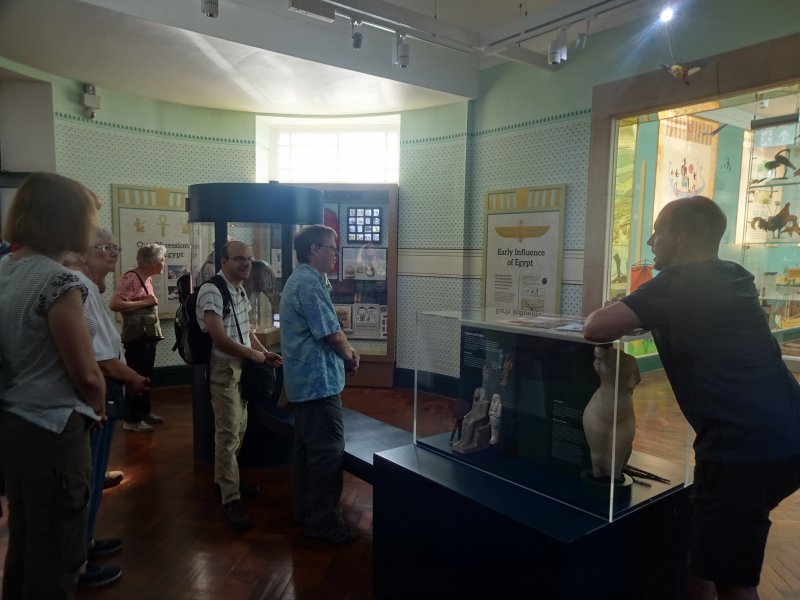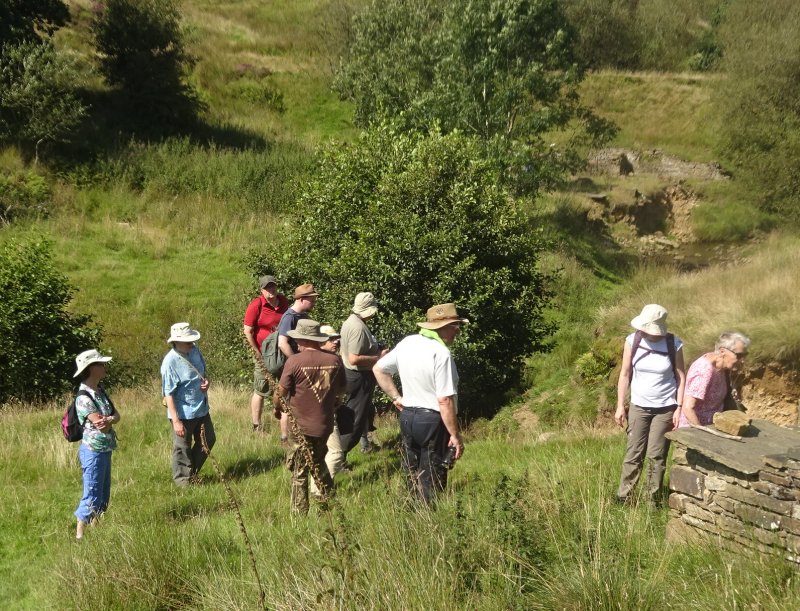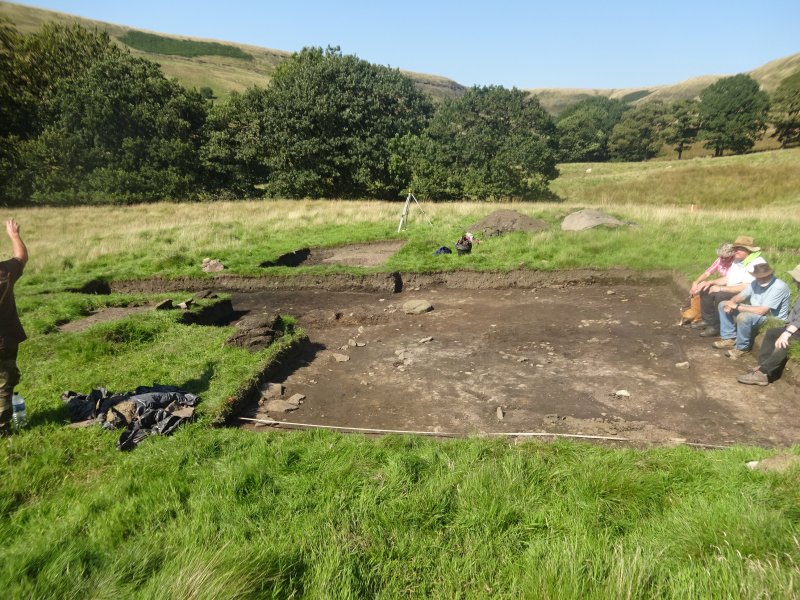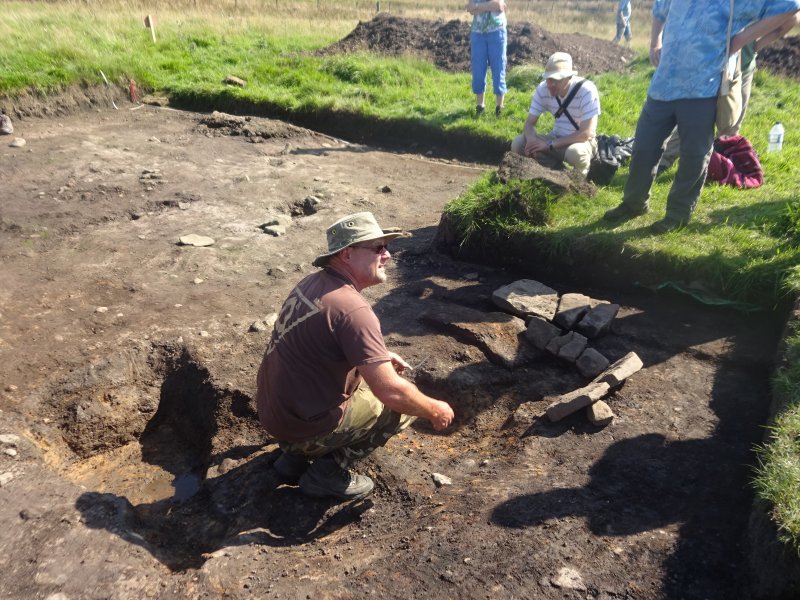Ian Trumble did us proud on Sunday with a great tour of the Egyptian Galleries at the Bolton Museum. Ian began by explain the origins of the collections which is spread across the 6 halls of the Museum. When the philanthropist Dr Samuel Chadwick died in 1876 he bequeathed £5000 for the building of a Museum of Natural History in the Queen’s Park. Opening in 1884 the Museum was soon filled with artefacts from around the world in particular Egypt. This was because of Bolton’s reputation as a leader in spinning and weaving of fine quality cotton. During the American Civil War, mill owners had been obliged switch there supply of raw material to the near east and thus became active in their support for all things Egyptian and in particular the Egypt Exploration Society, even raising money for their excavations. By the 1930’s the collections had long since outgrown the space available, but it was only in 1956 that the whole collection was transferred to the museum in the newly erected Crescent building behind the town hall. The Chadwick building, deemed to expensive to maintain was subsequently demolished (apparently with some artefacts, to big to move, still inside).
When the philanthropist Dr Samuel Chadwick died in 1876 he bequeathed £5000 for the building of a Museum of Natural History in the Queen’s Park. Opening in 1884 the Museum was soon filled with artefacts from around the world in particular Egypt. This was because of Bolton’s reputation as a leader in spinning and weaving of fine quality cotton. During the American Civil War, mill owners had been obliged switch there supply of raw material to the near east and thus became active in their support for all things Egyptian and in particular the Egypt Exploration Society, even raising money for their excavations. By the 1930’s the collections had long since outgrown the space available, but it was only in 1956 that the whole collection was transferred to the museum in the newly erected Crescent building behind the town hall. The Chadwick building, deemed to expensive to maintain was subsequently demolished (apparently with some artefacts, to big to move, still inside).  In 2016, in recognition of its importance, Bolton’s new Museum was awarded an initial HLF grant toward redevelopment of its Egyptian Gallery which is housed on its top floor. The following year, Bolton Council added a further £3.8m. The result is quite stunning with more than 2000 artefacts on display in an innovative array of self-supporting glass arches, creating a walkway that totally surrounds visitors with the collection.
In 2016, in recognition of its importance, Bolton’s new Museum was awarded an initial HLF grant toward redevelopment of its Egyptian Gallery which is housed on its top floor. The following year, Bolton Council added a further £3.8m. The result is quite stunning with more than 2000 artefacts on display in an innovative array of self-supporting glass arches, creating a walkway that totally surrounds visitors with the collection.  Cleverly arranged in chronological and typo-logical order, it tells the story of Egypt from the pre-dynastic period right through to the Greek and Roman eras. Amongst the many captivating exhibits, this ripple-flaked flint knife from the pre-dynastic period was my favourite.
Cleverly arranged in chronological and typo-logical order, it tells the story of Egypt from the pre-dynastic period right through to the Greek and Roman eras. Amongst the many captivating exhibits, this ripple-flaked flint knife from the pre-dynastic period was my favourite.  As previously mentioned Bolton’s Museum has an international reputation for researchers, particularly in the field of ancient textiles. Over the years, many pieces (particularly fragments that other museums weren’t interest in) were donated to the Museum, for the specialists to give their expert assessment. The result is the Museum owning some of the must important textile artefacts in the world including oldest know (so far) piece of woven cloth ever found. For me though, the final hall was the best – a full-scale recreation of the tomb of Thutmose III. This tomb (KV34) was found in 1898 and famously has the complete text of the New Kingdom’s funerary rites depicted on its walls. To help you to understand this infinitely complicated never ending daily ritual, an entertaining animation is screened on the walls. The tour was excellent and I would like to thank Ian on behalf our group for his well appreciated efforts.
As previously mentioned Bolton’s Museum has an international reputation for researchers, particularly in the field of ancient textiles. Over the years, many pieces (particularly fragments that other museums weren’t interest in) were donated to the Museum, for the specialists to give their expert assessment. The result is the Museum owning some of the must important textile artefacts in the world including oldest know (so far) piece of woven cloth ever found. For me though, the final hall was the best – a full-scale recreation of the tomb of Thutmose III. This tomb (KV34) was found in 1898 and famously has the complete text of the New Kingdom’s funerary rites depicted on its walls. To help you to understand this infinitely complicated never ending daily ritual, an entertaining animation is screened on the walls. The tour was excellent and I would like to thank Ian on behalf our group for his well appreciated efforts.
After our break for lunch, which included a tour around the Food Festival being held in the Bolton streets at the time, we teamed up and headed off to Holcombe Moor. Having passed through security at the entrance to the MOD Training Centre, we were met with Neil Coldrick, site director of the Holcombe Moor Heritage Group, who guided us along a rough track onto the moor to start our tour of their recent excavations. 
Firstly though, Neil was keen to show us the result of previous work on a site were they had spent 5 years uncovering the remains of an early 19th water mill. It was described as Cinder Hill Engine House on early maps but it was unclear exactly what it was they were manufacturing there. It was certainly water powered as it was located at the foot of the mill dam and the excavations had revealed the wheel pit. There was also evidence that the wheel had been relocated at some point for some reason. Artefacts recovered (including rollers for pulling raw cotton) suggest it was a spinning operation but it’s unsure whether this was an experimental water frame or spinning mule (or was it just manufacturing these items).  Leaving Mary behind at the mill (the terrain under foot was not particularly welcoming for her), Neil then guided us across the brook and up the over side of the valley to their more recent excavations. During their work at the mill, iron slag, charcoal and even iron ore, together with locally made medieval pottery, had been turning up in the valley over the years but the exact location of the production site was unknown.
Leaving Mary behind at the mill (the terrain under foot was not particularly welcoming for her), Neil then guided us across the brook and up the over side of the valley to their more recent excavations. During their work at the mill, iron slag, charcoal and even iron ore, together with locally made medieval pottery, had been turning up in the valley over the years but the exact location of the production site was unknown.  In 2018 Neil’s group, however, decided to investigate Cinder Hill itself. This area of the valley has experiences heavy use by the military over the years particularly in preparation for the two world wars – so before any excavation could began, residual ordinance has to be cleared. It was during this operation that a large signal was detected but instead of an unexploded shell or mortar, the soldiers uncovered what appeared to be the remains of a ancient bloomery furnace (although it was Neil himself who identified it as such). Fortunately, being an MOD site, funding was available for C14 dating and the results were quite astonishing; from the surrounding area between 1027-1182 cal AD and from the bloomery itself, late Saxon. If it can be confirmed, it means this is a remarkable site indicating a possible continuation of operations here over a long period.
In 2018 Neil’s group, however, decided to investigate Cinder Hill itself. This area of the valley has experiences heavy use by the military over the years particularly in preparation for the two world wars – so before any excavation could began, residual ordinance has to be cleared. It was during this operation that a large signal was detected but instead of an unexploded shell or mortar, the soldiers uncovered what appeared to be the remains of a ancient bloomery furnace (although it was Neil himself who identified it as such). Fortunately, being an MOD site, funding was available for C14 dating and the results were quite astonishing; from the surrounding area between 1027-1182 cal AD and from the bloomery itself, late Saxon. If it can be confirmed, it means this is a remarkable site indicating a possible continuation of operations here over a long period.  The site of the furnace as been back filled and this years excavations have so far failed to find further evidence of other smelting sites (although a metalled track through the site has been confirmed). What was new however was a depression not far from the bloomery site which Neil thinks is where the bellows would have been located.
The site of the furnace as been back filled and this years excavations have so far failed to find further evidence of other smelting sites (although a metalled track through the site has been confirmed). What was new however was a depression not far from the bloomery site which Neil thinks is where the bellows would have been located.  Neil hasn’t given up hope of find more evidence of smelting and excavations will continue next year to see if anything of a suspected enclosure can be found (he will be visiting us in November so he will be able to present any further findings from this year’s work).
Neil hasn’t given up hope of find more evidence of smelting and excavations will continue next year to see if anything of a suspected enclosure can be found (he will be visiting us in November so he will be able to present any further findings from this year’s work).
On are way back from Holcome, we decided to pay a visit to the roadside cross, reputed medieval, at Affetside. As it’s on the Roman road from Manchester to Ribchester, some have even claimed a Roman origin – although looking at it, it’s hard to imagine it being anything other than late medieval.  It is an unusual construction though, having circular stepped base in stead of the usual square. A socket on the very top of the column suggest a missing adornment (possibly the medieval cross itself). With no record of a market at Affetside in the middle ages, a suggested explanation for a cross here, was as a route marker for pilgrims on route to Whalley Abbey. It was a pleasant surprise though to see the cross fronting the village’s not long constructed Millennium Green.
It is an unusual construction though, having circular stepped base in stead of the usual square. A socket on the very top of the column suggest a missing adornment (possibly the medieval cross itself). With no record of a market at Affetside in the middle ages, a suggested explanation for a cross here, was as a route marker for pilgrims on route to Whalley Abbey. It was a pleasant surprise though to see the cross fronting the village’s not long constructed Millennium Green.  It’s construction was initiated in 1997 when the disused bus turn-around became available. Consisting of a large grassed area, it is centered by a substantial fish pond (apparently lovingly maintained by the local charitable trust). This last site served to top a very enjoyable day.
It’s construction was initiated in 1997 when the disused bus turn-around became available. Consisting of a large grassed area, it is centered by a substantial fish pond (apparently lovingly maintained by the local charitable trust). This last site served to top a very enjoyable day.
